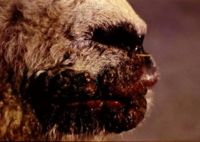Orf
| This article is still under construction. |
Also known as Contagious Pustular Dermatitis, Contagious Ecthyma and Scabby Mouth,
Orf is the most common viral zoonosis in the UK.
Morphology
- The virus is a large, enveloped, highly epitheliotropic, DNA virus which is ovoid in shape and measures 220‑300 x 140‑170 nm
- There are over 100 polypeptides in the virion
- The core proteins include a transcriptase and several other enzymes
- The virus is immunologically related to those causing bovine papular stomatitis, pseudocowpox, sealpox, deer PPV, red squirrel PPV and camel PPV
- There is extensive cross‑neutralization and cross‑protection between viruses belonging to the same genus, but not between those of different genera
- The virus is resistant to desiccation
- It is a parapox virus
Hosts
- Acute debilitating but rarely fatal skin disease of sheep, goats and incidentally of ruminants and humans
Pathogenesis
- Trauma, then lesions on skin without wool
- Lesions on udder and throat and in mouth
- Lesions coalesce to form scabbed masses
- Particular concern for lambs, who stop feeding due to mouth lesions
- For more, see here
- In man, papules and pustules develop on hands within 10 days, enlarge and then regress after several weeks
Epidemiology
- Morbidity may reach 90%, but mortality rarely exceeds 1%, unless secondary infection or myiasis occurs
- The course of the disease without complications is 2‑6 weeks, and it takes about 10 weeks to run a course through a naive flock, but often lingers indefinitely in the flock because it can reinfect the same animal many times and is resistant to desiccation
Differentials
- Sheep pox: A more severe disease
- Characterized by elevated papules distributed diffusely over the skin surface
- Inclusion bodies are often seen, but there is no down‑growth of epidermis
- High mortality
- Ulcerative dermatosis:
- Characterized by ulcers and crusts on the skin of the face, feet and genitalia
- The lesions are not elevated because there is no epithelial hyperplasia
- Bluetongue Virus:
- There is a lower morbidity but a high mortality
- The disease is usually seen in adult animals
- This is a severe systemic disease which is a differential only for the rare, systemic form of CE
- Mycotic dermatitis:
- The scabs are smaller and thinner and lighter and usually yellowish in color, with crusts not firmly attached
- Foot and mouth disease: When lesions occur in the mouth
- Poxviridae infection
- Quite a common zoonotic disease
Clinical
- In sheep produces a proliferative nodule/papular mass on lips
- In flocks in which it is endemic it is seen in lamb
- If flock is non-immune seen in ewes too but much worse in lambs (may spread to inside of mouth)
- Can spread to udder of ewe
Pathology
Papular proliferative pathology
- Poxvirus infections produce local infection of prickle cells in epithelium with proliferation of cells and formation of papule followed by ulceration / necrosis and covered by necrotic epithelium
- Eventually scabs form and crust drops off
- Scabs - very infectious ( N.B.if touch -> catch it)
Control
- Attenuated virus can be applied by scarification to axillar, causing scabs to fall off in 30 days
- Annual vaccination of ewes at least 8 weeks before lambing (all in contact should be done simultaneously)
- In an outbreak, all lambs can be vaccinated
From pathology
Contagious ecthyma
- Also called contagious pustular dermatitis, orf, sore mouth
- Caused by a parapox virus
- Affects mainly young sheep, less commonly cattle, humans, dogs
- Starts in abrasions around mouth commisures and spreads to lips, oral mucosa, eyelids and feet
- May also transfer to teats of the mother of an affected lamb
- Lesions typical of poxvirus but very brief vesicle stage
- Most obvious is the proliferative pustular stage
